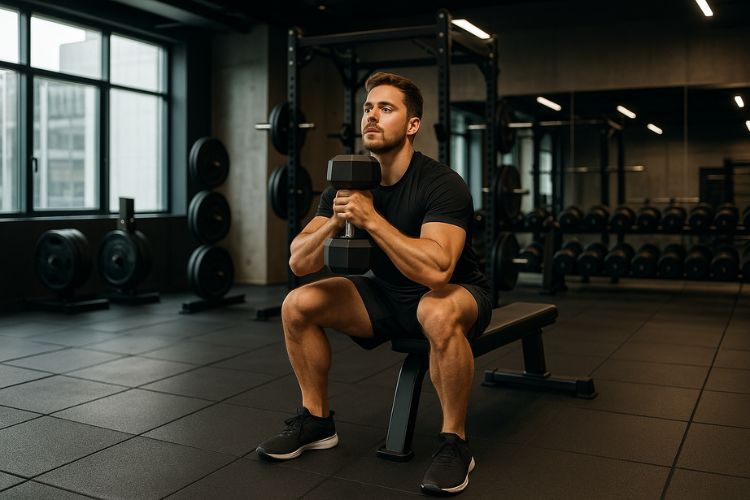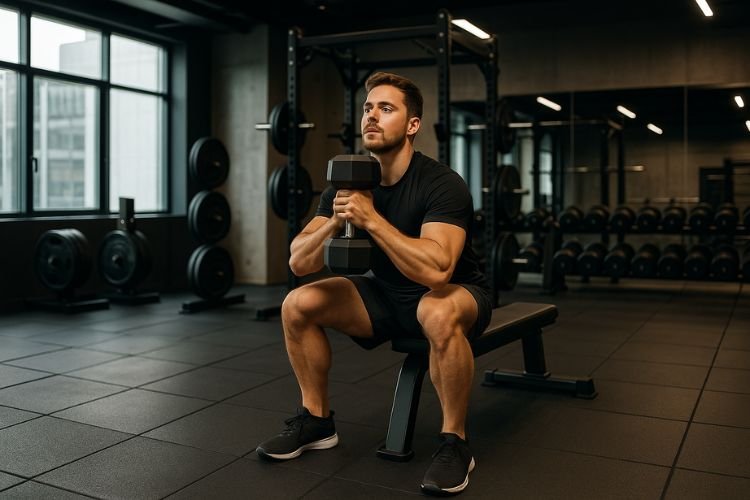
When it comes to building strength and muscle in the lower body, squats are often considered the king of exercises. However, not everyone has access to a barbell or squat rack, or may simply prefer a variation that’s easier on the joints. Enter it dumbbell bench squat—a flexible and effective move that targets your quads, glutes, hamstrings and core while being accessible to lifters of all levels.
In this comprehensive guide, we’ll dive deep into DBS, covering everything from its benefits and proper form to programming tips and common mistakes. Whether you’re a beginner or a seasoned athlete, this exercise can help you take your lower body workout to the next level.
What are Dumbbell Bench Squats?
Dumbbell bench squats, also known as squats with the help of a benchis a variation of the traditional squat that uses a bench for support and dumbbells for added resistance. This exercise is performed by sitting on your back on a bench or box and then standing up, holding dumbbells at your sides or in a goblet position.
The bench serves as a depth guide, ensuring you achieve the correct range of motion, while also providing a safety net for beginners who may struggle with balance. This makes the dumbbell bench squat a great option for those starting to squat or recovering from an injury.
Benefits of Dumbbell Bench Squats
1. Improved Squat form and depth
The bench works as touch, helping you learn how to sit comfortably in a squat with the proper depth. This is especially helpful for beginners who may struggle to hit parallel or below parallel in a traditional squat.
2. Reduced stress on the joints
Unlike barbell squats, which can put significant stress on the knees and lower back, dumbbell bench squats are a more joint-friendly option. The bench provides support and using dumbbells allows for a more natural movement pattern.
3. Enhanced core engagement
Holding dumbbells at your sides or in a goblet position forces your core to work harder to stabilize your body throughout the movement. This not only strengthens your abs and obliques but also improves overall balance and coordination.
4. Accessible for all fitness levels
Whether you’re a beginner or an advanced athlete, dumbbell squats can be easily modified to suit your fitness level. Beginners can start with bodyweight or light dumbbells, while more experienced lifters can increase the weight for an added challenge.
5. Flexibility in training
Dumbbell bench squats can be incorporated into a variety of training programs, including strength traininghypertrophy-focused workouts, even circuit training. It’s a great addition to your daily foot or body routine.
How to perform dumbbell bench squats with proper form
Proper form is crucial to maximizing the benefits of dumbbell bench squats while minimizing the risk of injury. Follow these step-by-step instructions to master the move:
Step 1: Set up your equipment
- Choose a flat bench or box that allows your knees to bend at a 90-degree angle when you sit.
- Choose a pair of dumbbells that challenge you but allow you to maintain proper form. Beginners can start with lighter weights or no weights at all.
2: Get the starting position
- Stand in front of the bench with feet shoulder-width apart and toes slightly pointed.
- Hold a dumbbell in each hand, allowing them to hang at your sides with your palms facing in. Alternatively, you can hold a single dumbbell in a goblet position (close to your chest).
3: Start the Movement
- Engage your core and keep your chest up as you begin to lower into the bench.
- Push your hips back and bend your knees, making sure they move over your toes.
4: Sit back on the bench
- Gently touch the bench with your buttocks, but avoid sitting down completely or relaxing your muscles.
- Keep your weight in your heels and keep the tension in your quads and glutes.
5: Stand Back Up
- Drive through your heels to push yourself back to the starting position.
- Squeeze your glutes at the top of the movement to fully engage your lower body.
6: Repeat
- Perform the desired number of repetitions, maintaining control and proper form throughout the set.
Common mistakes to avoid with the dumbbell bench
While dumbbell squats are relatively simple, there are a few common mistakes that can compromise your form and reduce the effectiveness of the exercise:
1. Rounding Your Back
Allowing your back to round during the movement can put unnecessary stress on your spine. Focus on keeping your chest and core engaged throughout the exercise.
2. Let your knees come in
Your knees should move over your toes and stay in line with your feet. If they recede inwards, it could indicate weak glutes or poor form.
3. Bouncing off the bench
Touching the bench too hard or bouncing off it can reduce muscle engagement and increase the risk of injury. Aim for controlled descent and ascent.
4. Using excessive weight
While it’s tempting to go heavy, using too much weight can compromise your form and lead to injury. Start with lighter weights and gradually increase as you build strength and confidence.
Programming Dumbbell Bench Squats into your workout
Dumbbell bench squats can be incorporated into your training program in a number of ways, depending on your goals. Here are some planning ideas:
For strength training
- Perform 3-5 sets of 5-8 reps with heavier weights.
- Rest for 2-3 minutes between sets to allow for full recovery.
Hypertrophy (Muscle Growth)
- Perform 3-4 sets of 8-12 reps with moderate weights.
- Rest for 60-90 seconds between sets to maintain intensity.
Endurance training or circuit training
- Perform 2-3 sets of 15-20 repetitions with lighter weights.
- Incorporate dumbbell bench squats into a circuit with other exercises such as push-ups, rows or lunges.
Advanced dumbbell bench squat variations and progressions
Once you’ve mastered the basic dumbbell bench squat, you can challenge yourself with these advanced variations:
1. One Leg Dumbbell Bench Squats
This unilateral variation increases the demand on your stabilizing muscles and helps address muscle imbalances. Perform the movement as usual, but lift one leg off the ground and squat the other.
2. Stopped Dumbbell Bench Squats
Add a 2-3 second pause at the bottom of the movement to increase time under tension and build strength at the bottom of the squat.
3. Dumbbell front rack bench squat
Hold the dumbbells at shoulder height with your elbows pointing forward. This variation puts more emphasis on your torso and upper back.
Tips for Maximizing Your Dumbbell Bench Squat Results
To get the most out of your dumbbell squats, keep these tips in mind:
- Warming up properly: Perform dynamic stretches and mobility exercises to prepare your lower body for movement.
- Focus on the mind-muscle connection: Focus on engaging your quads, glutes and hamstrings throughout the exercise.
- Gradual progress: Increase the weight or repetitions over time to continue to challenge your muscles.
- Combine with other exercises: Combine DBS with other lower-body movements like lunges, deadlifts, or leg presses for a well-rounded workout.
Dumbbell bench squats are a highly effective and affordable exercise for building lower body strength, improving squat form, and enhancing overall fitness. Whether you’re a beginner looking to master the basics or an advanced lifter looking for a new challenge, this move deserves a spot in your training routine.
By following the tips and techniques outlined in this guide, you can perform dumbbell squats with confidence and maximize your results. So grab a pair of dumbbells, find a bench and start squatting your way to stronger, stronger legs!
Consistency is key. Incorporate DBS into your workouts regularly and you’ll soon see improvements in strength, muscle tone and overall athletic performance. Happy lifting!
